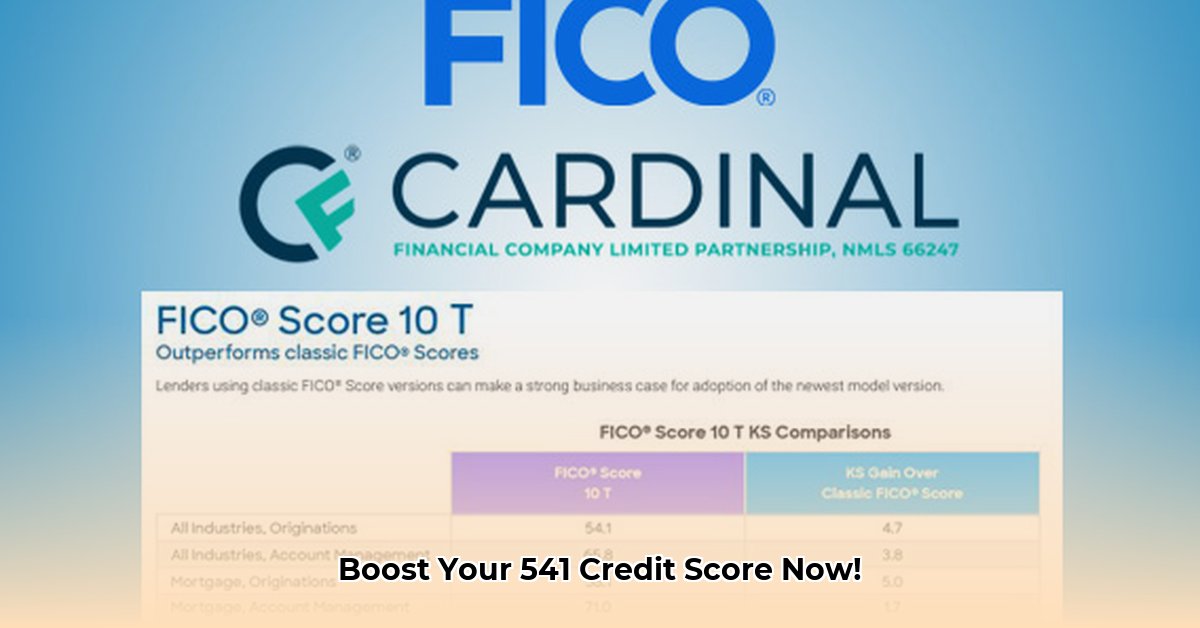
A 541 credit score can feel daunting, but it's not a life sentence. This guide provides a clear roadmap to improvement, focusing on actionable steps and empowering you to take control of your financial future. We'll break down complex concepts into simple terms, offering practical advice and celebrating every milestone along the way. Ready to embark on this journey? Let's begin!
Understanding Your Credit Score Situation
A 541 credit score is considered very poor. This impacts your ability to secure loans, credit cards, and even rent an apartment, often resulting in higher interest rates and reduced financial opportunities. But this isn't a dead end; it's a starting line. With consistent effort and the right strategy, you can significantly improve your score.
Step 1: Obtain Your Credit Reports and Dispute Errors
First, obtain your free credit reports from AnnualCreditReport.com. (Accessed March 27, 2024) Review each report meticulously for inaccuracies. Even a minor error—a wrong address, a debt you don't recognize—can negatively affect your score. Immediately dispute any errors with the credit bureaus; they're legally obligated to investigate. This foundational step sets the stage for accurate credit score improvement.
Step 2: Prioritize On-Time Payments
This is arguably the most crucial factor. Every on-time payment demonstrates reliability to lenders. Think of each payment as a building block in establishing a strong credit foundation. Automating payments or using reminders ensures consistency. Even small, consistent improvements over time compound significantly. Isn't consistent effort the bedrock of success in any endeavor?
Step 3: Manage Credit Utilization Effectively
Credit utilization is the percentage of your available credit you're using. Lenders prefer to see this below 30%. For example, with a $1000 credit limit, keeping your balance under $300 is ideal. High utilization signals potential financial strain. Pay down balances to lower this percentage; the impact on your score is substantial. How can you strategically reduce your credit card balances to boost your score?
Step 4: Address Existing Debt
Outstanding debts, especially past-due accounts, significantly harm your credit score. If overwhelmed, consider a debt management plan (DMP) from a reputable non-profit credit counseling agency. A DMP consolidates debts into a manageable monthly payment, simplifying your finances and freeing up cash flow. What resources are available to help you create a personalized debt repayment plan?
Step 5: Leverage Secured Cards and Credit-Builder Loans
Secured credit cards require a security deposit, acting as collateral and making approval easier. Credit-builder loans are explicitly designed to improve credit scores by demonstrating responsible repayment. Treat these responsibly—pay on time, every time. They powerfully signal to lenders your commitment to financial responsibility. What are the key differences between secured credit cards and credit-builder loans?
Step 6: Monitor Your Progress and Celebrate Achievements
Regularly check your credit reports (at least monthly) and track your progress. Improvement isn't instantaneous; patience is crucial. Celebrate every achievement, no matter how small. A 10-point increase is a significant win! Positive reinforcement maintains motivation throughout the process. How often should you monitor your credit score to track your progress effectively?
Roadmap to a Better Credit Score: A Realistic Timeline
This table provides a general timeline. Individual progress varies based on circumstances and actions taken.
| Timeframe | Action Steps | Expected Outcome |
|---|---|---|
| 0-3 Months | Obtain credit reports; correct errors; address urgent debts; ensure on-time payments; start lowering credit utilization | Improved payment history; small credit score increase; increased confidence |
| 3-6 Months | Continue consistent on-time payments; further reduce credit utilization; explore secured cards or credit-builder loans | Noticeable improvement in credit utilization; potential moderate score increase |
| 6-12 Months | Maintain excellent payment habits; possibly diversify credit (if responsible); continue monitoring your progress | Significant credit score improvement, potentially substantial increase |
| 12+ Months | Evaluate new credit options; maintain responsible credit utilization; possibly consider a personal loan for debt consolidation | Access to better financial products; improved financial health and freedom |
Remember, improving your credit is a marathon, not a sprint. Consistent effort and a strategic approach will lead you towards a healthier financial future. You've got this!